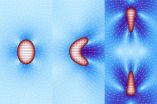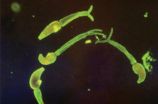(Press-News.org) ITHACA, N.Y. – Cornell scientists have created the first vaccines that can prevent metritis, one of the most common cattle diseases. The infection not only harms animals and farmers' profits, but also drives more systemic antibiotic use on dairy farms than any other disease.
The new vaccines prevent metritis infection of the uterus from taking hold and reduce symptoms when it does, a prospect that could save the United States billions of dollars a year and help curb the growing epidemic of antibiotic resistance. The research was published in the journal PLOS One.
Metritis develops after a cow gives birth, when bacteria take advantage of the open vagina and cervix to settle in the uterus. Infected cows suffer fever, pain, inflammation, lack of appetite, depression and reduced reproductive abilities. Metritis affects as many as 25 percent of the roughly 9 million dairy cows in the United States, costing nearly $400 per case in lost productivity and treatment costs.
It is the number one cause of systemic antibiotic use, which floods the whole body with antibiotics rather than just a specific region, said Rodrigo Bicalho, assistant professor of dairy production medicine at the College of Veterinary Medicine. Three of the vaccines Bicalho's lab created lowered metritis incidence and lessened its symptoms in the cows that received them, showing promise for alternatives to antibiotics in addressing the disease.
"Our lab has been developing a vaccine for years now based on our research of this disease," said Bicalho. "We created multivalent vaccines, complex cocktails with several components we've identified as important to causing metritis."
Bicalho and his lab researchers tested five combinations of various ingredients and delivered three subcutaneously via a shot and two intravaginally. All three subcutaneous vaccines were effective, significantly reducing incidence of disease by up to 83 percent. Cows that were vaccinated with the subcutaneous vaccines had lower incidence of postpartum fever and puerperal metritis, shorter disease periods and improved reproductive performance compared to those that did not receive the vaccines.
"The powerful protection these vaccines produced surprised us. We expected some protective effect but nothing as strong as what we found," said Bicalho. "An effective vaccine against uterine diseases will have a significant positive impact on the dairy industry, limiting the use of antibiotics, and decreasing economic losses due to these disorders. Our next step is to simplify the complex vaccines we created by identifying which components are the most important and removing the rest."
INFORMATION: END
First metritis vaccine protects dairy cows
2014-04-16
ELSE PRESS RELEASES FROM THIS DATE:
At the origin of cell division
2014-04-16
Droplets of filamentous material enclosed in a lipid membrane: these are the models of a "simplified" cell used by the SISSA physicists Luca Giomi and Antonio DeSimone, who simulated the spontaneous emergence of cell motility and division - that is, features of living material - in inanimate "objects". The research is one of the cover stories of the April 10th online issue of the journal Physical Review Letters.
Giomi and DeSimone's artificial cells are in fact computer models that mimic some of the physical properties of the materials making up the inner content and ...
EU must take urgent action on invasive species
2014-04-16
The EU must take urgent action to halt the spread of invasive species that are threatening native plants and animals across Europe, according to a scientist from Queen's University Belfast.
The threats posed by these species cost an estimated €12 billion each year across Europe. Professor Jaimie Dick, from the Institute for Global Food Security at Queen's School of Biological Sciences, is calling on the EU to commit long-term investment in a European-wide strategy to manage the problem.
Invasive species are considered to be among the major threats to native biodiversity ...
Expect changes in appetite, taste of food after weight loss surgery
2014-04-16
Changes in appetite, taste and smell are par for the course for people who have undergone Roux-en-Y gastric bypass surgery during which one's stomach is made smaller and small intestines shortened. These sensory changes are not all negative, and could lead to more weight loss among patients, says Lisa Graham, lead author of a study by researchers from Leicester Royal Infirmary in the UK. Their findings, published in Springer's journal Obesity Surgery showed that after gastric bypass surgery, patients frequently report sensory changes.
Graham and her colleagues say their ...
Fish exposed to antidepressants exhibit altered behavioral changes
2014-04-16
Amsterdam, April 16, 2014 - Fish exposed to the antidepressant Fluoxetine, an active ingredient in prescription drugs such as Prozac, exhibited a range of altered mating behaviours, repetitive behaviour and aggression towards female fish, according to new research published on in the latest special issue of Aquatic Toxicology: Antidepressants in the Aquatic Environment.
The authors of the study set up a series of experiments exposing a freshwater fish (Fathead Minnow) to a range of Prozac concentrations. Following exposure for 4 weeks the authors observed and recorded ...
Study: The trials of the Cherokee were reflected in their skulls
2014-04-16
Researchers from North Carolina State University and the University of Tennessee have found that environmental stressors – from the Trail of Tears to the Civil War – led to significant changes in the shape of skulls in the eastern and western bands of the Cherokee people. The findings highlight the role of environmental factors in shaping our physical characteristics.
"We wanted to look at these historically important events and further our understanding of the tangible human impacts they had on the Cherokee people," says Dr. Ann Ross, a professor of anthropology at NC ...
Progress in understanding immune response in severe schistosomiasis
2014-04-16
BOSTON (April 16, 2014) —Researchers at the Sackler School of Graduate Biomedical Sciences at Tufts and Tufts University School of Medicine (TUSM) have uncovered a mechanism that may help explain the severe forms of schistosomiasis, or snail fever, which is caused by schistosome worms and is one of the most prevalent parasitic diseases in the world. The study in mice, published online in The Journal of Immunology, may also offer targets for intervention and amelioration of the disease.
Schistosomiasis makes some people very sick whereas others tolerate it relatively well, ...
Floating nuclear plants could ride out tsunamis
2014-04-16
CAMBRIDGE, Mass-- When an earthquake and tsunami struck the Fukushima Daiichi nuclear plant complex in 2011, neither the quake nor the inundation caused the ensuing contamination. Rather, it was the aftereffects — specifically, the lack of cooling for the reactor cores, due to a shutdown of all power at the station — that caused most of the harm.
A new design for nuclear plants built on floating platforms, modeled after those used for offshore oil drilling, could help avoid such consequences in the future. Such floating plants would be designed to be automatically cooled ...
Bristol academics invited to speak at major 5G summit
2014-04-16
For more than 20 years academics from the University of Bristol have played a key role in the development of wireless communications. In particular, they have contributed to the development of today's Wi-Fi and cellular standards. Two Bristol engineers, who are leaders in this field, have been invited to a meeting of technology leaders to discuss the future of wireless communications. The first "Brooklyn 5G Summit" will be held next week [April 23-25] in New York, USA.
Andrew Nix, Professor of Wireless Communication Systems and Mark Beach, Professor of Radio Systems ...
Researchers question emergency water treatment guidelines
2014-04-16
The Environmental Protection Agency's (EPA's) recommendations for treating water after a natural disaster or other emergencies call for more chlorine bleach than is necessary to kill disease-causing pathogens and are often impractical to carry out, a new study has found. The authors of the report, which appears in the ACS journal Environmental Science & Technology, suggest that the agency review and revise its guidelines.
Daniele Lantagne, who was at the Centers for Disease Control and Prevention (CDC) at the time of the study and is now at Tufts University, and colleagues ...
Relieving electric vehicle range anxiety with improved batteries
2014-04-16
RICHLAND, Wash. – Electric vehicles could travel farther and more renewable energy could be stored with lithium-sulfur batteries that use a unique powdery nanomaterial.
Researchers added the powder, a kind of nanomaterial called a metal organic framework, to the battery's cathode to capture problematic polysulfides that usually cause lithium-sulfur batteries to fail after a few charges. A paper describing the material and its performance was published online April 4 in the American Chemical Society journal Nano Letters.
"Lithium-sulfur batteries have the potential to ...


